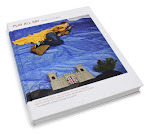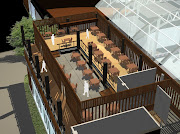
Zoka Zola Architecture was selected to participare in an international competition for Zero Energy Housing, on six sites in the middle of Sentul Park in Kuala Lumpur.

The competition brief is to built houses that work in harmony with the environment, made by renewable materials, able to generate its own energy and recycle water.

Why it is named as Rafflesia House?
The design unintentionally looks like the Rafflesia, the largest flower in the world and which is a national symbol for Malaysia. Rafflesia use 9 months to develop from bud into a flower and the flower only lasted for a few days. Rafflesia is a known as a parasite, because it is unable to produce its own chlorophyll and not capable of photosynthesis. It did not begin its life as a parasite, but evolved this lifestyle. Biologists do not know what the Rafflesia’s function is in its ecosystem.

One question evolved from the above : What is the function of the humans in the world's ecosystem?
The winning design is a study of the balance of human habitat with the surroundings. The intentions of the designer is to integrate the habitat with the climate, urban, site specific ecosystem with the human needs. The house sits on 12 columns to allow other species to develop around it.


The patterns of wind flow is well studied and implemented into the design. Concave and convex wall work together to direct the winds into the house through open windows and doors. The whole building is raised up, therefore a good ventilation is mantained in and out of the house. One half of the house is also higher than the other half. Ceiling fans are used to encourage more air movement and certain zones are air conditioning as the desires of the users.

All info and images from
Zoka Zola Architecture and view another entry for the competition by the ZOKA ZOLA.







 Above is one of the winning projects 2009 : Regional Museum of Mine Site: North of Chile by South America/Chile/Santiago-Universidad del Desarollo-Arquitectura
Above is one of the winning projects 2009 : Regional Museum of Mine Site: North of Chile by South America/Chile/Santiago-Universidad del Desarollo-Arquitectura

















 All info and images from
All info and images from 

 balancity – a city in balance between renewal and preservation, innovation and tradition, urbanity and nature, society and its individuals, work and recreation, and finally, between globalisation and national identity.
balancity – a city in balance between renewal and preservation, innovation and tradition, urbanity and nature, society and its individuals, work and recreation, and finally, between globalisation and national identity. 


 The balance between landscape and structure are vivid throughout the spaces. Visitors will start their journey from a terraced landscape of event area at ground floor up to third floor. 4 exhibition structures are hover at the sky. The interplay of interior and exterior spaces, of light and shadows, of closeness and vastness, are withness along the journey.
The balance between landscape and structure are vivid throughout the spaces. Visitors will start their journey from a terraced landscape of event area at ground floor up to third floor. 4 exhibition structures are hover at the sky. The interplay of interior and exterior spaces, of light and shadows, of closeness and vastness, are withness along the journey.


 There are two categories of heritage – natural and cultural. An example of natural heritage is Mulu National Park. Cultural heritage exists in both tangible (eg building) and intangible (e.g traditional dance). Be it tangible or intangible, cultural heritage must be linked with the cultural value of the society that has produced it. Thus the public has to be aware of any effort to conserve our Cultural Heritage to ensure support from the society concerned.
There are two categories of heritage – natural and cultural. An example of natural heritage is Mulu National Park. Cultural heritage exists in both tangible (eg building) and intangible (e.g traditional dance). Be it tangible or intangible, cultural heritage must be linked with the cultural value of the society that has produced it. Thus the public has to be aware of any effort to conserve our Cultural Heritage to ensure support from the society concerned.
 The day will consit of six technical seminars, ranging from indentifying and meeting legislative and planning requirements through to fire safety challenges and solutions. Simon Linford of Linford Group Limited will also deliver a presentation on Regenerating historic buildings: A Contractor's Perspective.
The day will consit of six technical seminars, ranging from indentifying and meeting legislative and planning requirements through to fire safety challenges and solutions. Simon Linford of Linford Group Limited will also deliver a presentation on Regenerating historic buildings: A Contractor's Perspective. All presentations will be presented by construction industry professionals and will provide examples of appropriate solutions from recent case studies along with practical advice, both of which will help you. Attending this event will also provide you with an excellent opportunity to network with specialist consultants within this industry sector.
All presentations will be presented by construction industry professionals and will provide examples of appropriate solutions from recent case studies along with practical advice, both of which will help you. Attending this event will also provide you with an excellent opportunity to network with specialist consultants within this industry sector.
 Retreats in the landscape: Swamp hut ,Newton, Massachusetts
Retreats in the landscape: Swamp hut ,Newton, Massachusetts
 Designed by Moskow Linn Architects. 4 huts arranged surrounding a central outdoor deck , serving different purposes individually. All huts sit lightly on site with four A frame structure.
Designed by Moskow Linn Architects. 4 huts arranged surrounding a central outdoor deck , serving different purposes individually. All huts sit lightly on site with four A frame structure.




 This project was named as Watershed house , part of the clients watershed ecological restoration project, the component parts of the studio would be fully recyclable and detachable, allowing the building to be completely dismantled and reused when its natural life cycle ended.
This project was named as Watershed house , part of the clients watershed ecological restoration project, the component parts of the studio would be fully recyclable and detachable, allowing the building to be completely dismantled and reused when its natural life cycle ended.
 The building contains a 100 square foot room with writing desk and cabinets, no electricity , plumbing system and heating systems are found in this building. The studio relies on passive solar heating and ventilation .
The building contains a 100 square foot room with writing desk and cabinets, no electricity , plumbing system and heating systems are found in this building. The studio relies on passive solar heating and ventilation .



 “The amount of daylight entering the second level is such a welcome surprise,” says the client, who uses the work space only during the day. At night, the sitting area at the opposite end of the room functions as a screening room for films.
“The amount of daylight entering the second level is such a welcome surprise,” says the client, who uses the work space only during the day. At night, the sitting area at the opposite end of the room functions as a screening room for films. 






